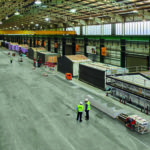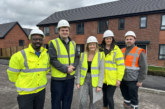 Dave Sheridan, Executive Chairman of ilke Homes, discusses how MMC can ease the pressure on the construction industry and deliver better, more affordable homes.
Dave Sheridan, Executive Chairman of ilke Homes, discusses how MMC can ease the pressure on the construction industry and deliver better, more affordable homes.
In 2017/18, local authorities across the UK constructed just 6,463 homes despite the last government’s aim for councils to take on a bigger housebuilding role with the removal of the Housing Revenue Account borrowing cap. Meanwhile, the total number of new homes built in 2018 reached 159,617, almost half that of the Government’s 300,000 a year target.
As local authorities continue to struggle with chronic underfunding, and the construction industry continues to deal with labour shortages, Brexit uncertainty and several high-profile insolvencies — such as Carillion and Interserve — public-private partnerships (PPPs) will have to play a vital role.
But the tried and tested models of housebuilding have proven to be unable to deliver to the required scale. As such, local authorities and the housebuilding industry must look towards innovative solutions. And it is the modern methods of construction where these solutions lie (MMC).
Over the past six months, investment in housebuilding has coalesced around MMC. Our £100m strategic partnership with Places for People in May was testament to the confidence that modular is a high-growth market and this step-change in strategy from the country’s biggest housing association demonstrates its mass-market appeal.
Partnerships like this can take the strain off local authorities and invigorate housebuilders, whilst encouraging the development of affordable housing.
Wider crisis
The affordable housing crisis goes deeper than that of the wider housing crisis, with people living on housing benefit unable to afford any single rooms available for private rent in large parts of London and Greater Manchester.
To solve this issue, the private sector must be more willing to engage with local authorities. For us, working with local authorities to deliver high-quality, sustainable homes available for social rent is priority number one.
Strategic partnerships between the public sector and modular housing providers are emerging. Homes England supported our deal with Places for People as well as that of the deal between Japan’s largest housebuilder Sekisui House and Urban Splash. A number of local authorities have got in on the act too, with modular homes being developed by councils across the country, from London to Newcastle.
It’s clear why the orders are stacking up. Modular almost sells itself: it’s twice as fast as traditional construction methods, can reduce onsite waste by almost 90%, while also using 67% less energy in the manufacturing and construction process, according to the Government’s recent report into MMC. Thanks to cutting-edge technology, we can generate precise estimations of the material needed. While this helps significantly reduce waste, it also delivers certainty to the supply chain with a steady and consistent stream of material orders.
Building offsite at scale
The main issue that the sector currently faces is scale. Offsite manufacturing represented less than 15% of the total homes built in 2016/17. Reaching the Government’s targets of 300,000 new homes a year — of which there is still a shortfall of nearly 100,000 — will require offsite manufacturing’s contribution to rapidly increase.
Not only can offsite manufacturing deliver homes up to 50% faster than traditional construction but it also drastically reduces the pressure the skills shortage is having on the industry by offering sustainable and adaptable jobs to unskilled workers who can be quickly trained up in MMC.
Although the money has been flowing in, to scale up the sector will require further investment. Setting up the factories, the technologies, the prototypes and training of the workforce is a costly business.
If we are to solve the housing crisis and ensure that everyone can genuinely afford their own home, then investment into modular is the place to start. By doing so, we can ease the pressure on the construction industry and deliver better, more affordable homes to the people and places that need them.
Header image shows the inside of ilke Homes’ factory.









